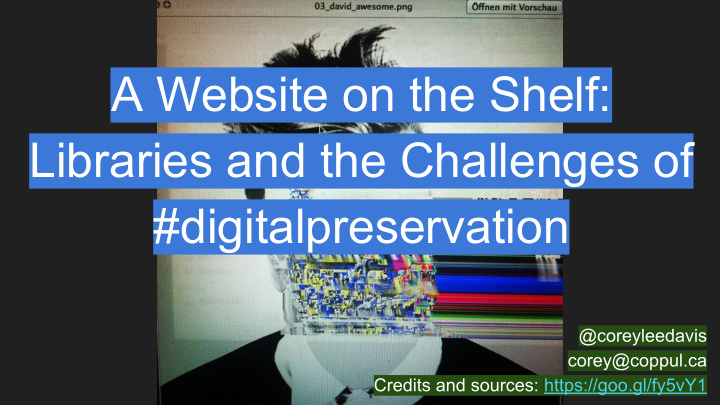



A Website on the Shelf: Libraries and the Challenges of #digitalpreservation @coreyleedavis corey@coppul.ca Credits and sources: https://goo.gl/fy5vY1
Academic libraries are responsible for preserving and providing access to the scholarly record
That record is evolving and increasingly digital
Bitstreams are not intelligible without the data formats, applications, operating systems, and hardware environments to Systems are modified interpret them and replaced over time
“Traditionally, preserving things meant keeping them unchanged; however our digital environment has fundamentally changed our concept of preservation requirements. If we hold on to digital information without modifications, accessing the information will become increasingly difficult, if not impossible.” Chen, S. S. (2001). The paradox of digital preservation. Computer , 34(3), 24-28.
➔ News ➔ Government information ➔ Digitized collections ➔ Theses and dissertations ➔ Research data ➔ Journals and books ➔ Websites ➔ Code ➔ Institutional records ➔ Etc., etc.
➔ News ➔ Government information ➔ Digitized collections ➔ Theses and dissertations ➔ Research data ➔ Journals and books ➔ Websites ➔ Code ➔ Institutional records ➔ Etc., etc.
“Digital preservation involves planning, resource allocation, and application of preservation methods and technologies, and it combines policies, strategies and actions to ensure access to content, regardless of the challenges of media failure and technological change.” Wikipedia, Digital Preservation
Digital preservation is not primarily a technical problem
Depository Services Program, c. 1927 Created to acquire, catalogue and distribute federal government publications to a network of libraries
● Library and Archives Canada ● The Library of Parliament ● Libraries of federal departments and research bureaus ● Provincial and legislative libraries ● Municipal and provincial public libraries ● Foreign national libraries ● Foreign university libraries with Canadian Studies programs ● Libraries of foreign legislatures and parliaments ● Libraries of public post-secondary institutions
“All content included in or made available through any Amazon.ca Service is the property of Amazon.ca.” Amazon.ca Conditions of Use , 2016
Canadian Government Information Digital Preservation Network: CGI-DPN ● Dalhousie University ● McGill University Web archiving ● Scholar’s Portal ● Simon Fraser University ● Stanford University ● University of Alberta ● University of British Columbia Distributed ● University of Calgary Independently administered ● University of Saskatchewan Library-owned ● University of Toronto Preservation storage ● University of Victoria
Public Knowledge Project Private LOCKSS Network: PKP-PLN ● Ghent University Library Provides preservation services for any ● University of Alberta Open Journal System (OJS) journal that ● University of British Columbia has published at least one article and has ● Indiana University an ISSN ● University of Pittsburgh ● University of Victoria ● Simon Fraser University ● Scholars Portal ● Italian National Library of Florence
Canadian Research Knowledge Network Trusted Digital Repository Task Group: CRKN TDRTG ● CRKN’s 75 members Developing a framework for establishing a national TDR for CRKN members to represents all research ensure long-term access to universities and most others, CRKN-licensed resources and to provide with over 1,000,000 full-time a publisher-independent mechanism for equivalent faculty and exercising post-cancellation rights students ● Undertakes large-scale content acquisition and licensing initiatives
Keepers “…represents only about 20% of the ‘continuing resources’ and ‘integrated resources’ having an ISSN.” Peter Burnhill, EDINA & Françoise Pelle, ISSN International Centre
➔ Collecting primary web-based source material ➔ Representing voices marginalized in traditional collections Web archiving ➔ Web archives as research data ➔ Capturing the evolving scholarly record
➔ Legal issues ➔ Tools and services (and how to pay for them) ➔ Local policies and workflows, including selection ➔ Metadata ➔ Archival storage for WARCs
“The boundaries of the scholarly record are shifting and blurring...to include research data sets, computer models, interactive programs, complex visualizations, lab notebooks, and a host of other materials” Lavoie, B., Childress, E., Erway, R., Faniel, I., Malpas, C., Schaffner, J., & van der Werf, T. (2014). The Evolving Scholarly Record . OCLC.
Amnesiac civilization “I've been warning for some time that one of the fundamental problems facing digital preservation is the evolution of content from static to dynamic.” Dr. David Rosenthal, 2017
➔ With AJAX and HTML5, the web is transitioning from a document-centric information space, to an applications-based information space ➔ Content is tailored to people, locations, and devices. There is no “canonical version” of a webpage.
“In short, the archival failure is caused by changes CNN made to their CDN (content delivery network); these changes are reflected in the JavaScript used to render the homepage.” John Berlin, Web Science and Digital Libraries Research Group at Old Dominion University
● Canadian Association of Research Libraries (CARL) ● Community of practice Canadian Web ● Strengthening and deepening collaboration Archiving Coalition ● Best practices ● Legal guidance Repatriate WARCs using Make datasets available to Provide discounts on Develop mechanisms researchers via a consortial license to Ontario Libraries to collaboratively Research Cloud (OLRC) Canadian instance of Archive-It create collections Dataverse
Starting from creation and ingest, we should integrate the workflow process with the preservation process…” Chen, S. S. (2001). The paradox of digital preservation. Computer , 34(3), 24-28.
Librarians, developers, and scholars working together to preserve the evolving scholarly record
“As we witness physical works of art destroyed by war and the passage of time around the world, we know how important preservation is. The same is true for creative expressions online—and we must look for new solutions together.” Vint Cerf
Thanks! #digitalpreservation @coreyleedavis corey@coppul.ca Credits and sources: https://goo.gl/fy5vY1
Recommend
More recommend